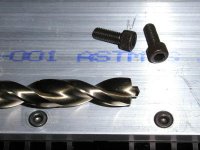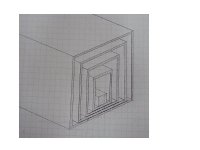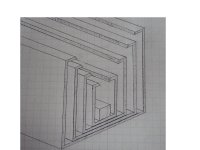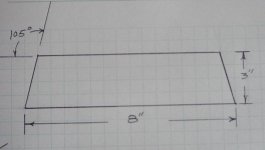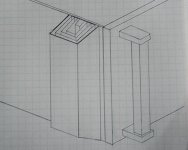It is copied from another thread and I find it the easiest way to do recessed holes for Allen type bolts. They also look better than anything else. You could use special drillbits, but I imagine they might be expensive:
>I use Pilot Point, Twist Drills from DeWalt or from Black&Decker sold under "Bullet" name and available from Home Depot. Those are my favourite drill bits.
For screw head hole size I choose a drill bit next size up and measure the pilot size. I drill a pilot hole first. Then choose the slowest speed on my drill press (which for that purpose is necassary) and drill the big hole for the screw head (adjust the deph of the hole first). Than I drill through the final hole for the screw with a regular bit (because the pilot is smaller than screw size).<
>I use Pilot Point, Twist Drills from DeWalt or from Black&Decker sold under "Bullet" name and available from Home Depot. Those are my favourite drill bits.
For screw head hole size I choose a drill bit next size up and measure the pilot size. I drill a pilot hole first. Then choose the slowest speed on my drill press (which for that purpose is necassary) and drill the big hole for the screw head (adjust the deph of the hole first). Than I drill through the final hole for the screw with a regular bit (because the pilot is smaller than screw size).<
Attachments
I gave up on the CAD program for awhile until I get through the tutorial. But I can still operate a pencil and ruler  Here is pic. It is composed of 3"x3"x.126" box tubing the steps down in 1/2" increments until 1-1/2" and 3/4" bar which is blind drilled and tapped to hold the hole thing together. The final piece will not be end cut at 90 degrees but more like 105 to promote the chimney effect at the bottom.
Here is pic. It is composed of 3"x3"x.126" box tubing the steps down in 1/2" increments until 1-1/2" and 3/4" bar which is blind drilled and tapped to hold the hole thing together. The final piece will not be end cut at 90 degrees but more like 105 to promote the chimney effect at the bottom.
Attachments
Good drawing! It would seem suited for forced air cooling. You should end up with something unique.
As to whether to gut it out not I would choose an intermediate solution, leaving the 3x3 intact and cutting the rest open. If you cut the 3x3 out you loose the bulk of the surface. I have some reservation as for the real utility of the inner layers anyway as you are adding more and more thermal couplings.
Why not start from bigger tubing? 5 x 5?
As to whether to gut it out not I would choose an intermediate solution, leaving the 3x3 intact and cutting the rest open. If you cut the 3x3 out you loose the bulk of the surface. I have some reservation as for the real utility of the inner layers anyway as you are adding more and more thermal couplings.
Why not start from bigger tubing? 5 x 5?
I'm planning on a frugal Aleph-X as well. Have you done any calculations on a scaled-down variant yet?Dennis Hui said:
Peter, thanks for your comments. The frugal Aleph-X is what
I plan on building. The 'parallel heatsink' question was
more for my friend with the Apogees, who will need to build
high current Aleph-Xs.
Philip-
I like that idea, though I would vote for the one without the section cut out.
I especially like the fact that you have large flat areas on each tube to make the interface with the next one. Of course, like grataku mentions, there is a thermal resistance at each interface, but if you use plenty of screws and silicone heat-sink sauce between them all it might work pretty well.
If you want to dissipate something like 300 watts all told, you will need something like 3000 in^2 of area, under the assumption that you can spread the devices out over the thing somewhat.
Are you planning two monoblocks?
I was thinking of something similar with some round 2.5 in and 3 in. al tubing I have; a series of pipes somewhat like organ pipes, sticking out of a somewhat lower-profile box. Maybe a takeoff on architecture of power plants from the 30's. But I've set that aside to concentrate on getting some electronics built instead, right now.
I think as Grataku suggests, that it would be especially good for forced-air cooling, to keep the size of the thing under control- maybe about 1/3 the size of the natural convection version.
I don't get your mention of 105 degrees vs. 90- are you talking about some area inside the chassis to provide an inlet? If so I can discuss possibly better ideas w/you (eg. you need area at least as large as the cross-section of your stack, or you starve it for air....and how does that get into your chassis?).
I guess we're jacking this thread..... Maybe start a new one?
I like that idea, though I would vote for the one without the section cut out.
I especially like the fact that you have large flat areas on each tube to make the interface with the next one. Of course, like grataku mentions, there is a thermal resistance at each interface, but if you use plenty of screws and silicone heat-sink sauce between them all it might work pretty well.
If you want to dissipate something like 300 watts all told, you will need something like 3000 in^2 of area, under the assumption that you can spread the devices out over the thing somewhat.
Are you planning two monoblocks?
I was thinking of something similar with some round 2.5 in and 3 in. al tubing I have; a series of pipes somewhat like organ pipes, sticking out of a somewhat lower-profile box. Maybe a takeoff on architecture of power plants from the 30's. But I've set that aside to concentrate on getting some electronics built instead, right now.
I think as Grataku suggests, that it would be especially good for forced-air cooling, to keep the size of the thing under control- maybe about 1/3 the size of the natural convection version.
I don't get your mention of 105 degrees vs. 90- are you talking about some area inside the chassis to provide an inlet? If so I can discuss possibly better ideas w/you (eg. you need area at least as large as the cross-section of your stack, or you starve it for air....and how does that get into your chassis?).
I guess we're jacking this thread..... Maybe start a new one?
No  not I am jacking the thread from the purchase, but I would start a thread if thereis some interest in this. I am actually buying some of the sinks this thread has decided upon. Peter and grataku were making some comments and showing some of their projects and I wanted theirs' and others opinions. This thread is about heatsinks after all. What better way to say "DIY" than making your own heatsinks. Even if it is for a later project. I really do appreciate all the comments on the heatsinks themselves. I have thought some more about this idea and might go down to 1" square tubing then use a 1/2" tapped bar stock as the "nut" on the inside. This would give me more mass. I do have a concern with the conduction surface and the number of surfaces I am trying to go across. I can never duplicate the conduction abililty of solid aluminum. I can drill some odd holes between the the screws and make some welds down to the smallest tubing but I think that throws a wrench into most peoples ability. I feel these heat sinks can be done by anyone with a chopsaw and a drill press. Not to mention the fact that there might not be that much gain from it over the heatsink grease. My initial Aleph X project will be a couple sets of monoblocks for myself and my dad, but I also want to build a lower power integrated amp as well. I am going to try and get some the tubing together through "shorts bin" purchases and see the what ability the sinks have. I have looked into home anodizing and might make them into some wild color as well, like "molten red".
not I am jacking the thread from the purchase, but I would start a thread if thereis some interest in this. I am actually buying some of the sinks this thread has decided upon. Peter and grataku were making some comments and showing some of their projects and I wanted theirs' and others opinions. This thread is about heatsinks after all. What better way to say "DIY" than making your own heatsinks. Even if it is for a later project. I really do appreciate all the comments on the heatsinks themselves. I have thought some more about this idea and might go down to 1" square tubing then use a 1/2" tapped bar stock as the "nut" on the inside. This would give me more mass. I do have a concern with the conduction surface and the number of surfaces I am trying to go across. I can never duplicate the conduction abililty of solid aluminum. I can drill some odd holes between the the screws and make some welds down to the smallest tubing but I think that throws a wrench into most peoples ability. I feel these heat sinks can be done by anyone with a chopsaw and a drill press. Not to mention the fact that there might not be that much gain from it over the heatsink grease. My initial Aleph X project will be a couple sets of monoblocks for myself and my dad, but I also want to build a lower power integrated amp as well. I am going to try and get some the tubing together through "shorts bin" purchases and see the what ability the sinks have. I have looked into home anodizing and might make them into some wild color as well, like "molten red".
Philo,
I don't feel you are hijacking this thread. Actually the thread has done its job, we have more than 200 heatsinks. Since it's the weekend there is nothing to be added from the practical/administrative standpoint until tomorrow, people posting here now actually send the thread up in the hit parade and give it more visibility so more people may sign in the wiki page.
Sort of like the bees pollinating different flowers thereby actively, though unknowingly, part taking in the endless cycle of life.
I don't feel you are hijacking this thread. Actually the thread has done its job, we have more than 200 heatsinks. Since it's the weekend there is nothing to be added from the practical/administrative standpoint until tomorrow, people posting here now actually send the thread up in the hit parade and give it more visibility so more people may sign in the wiki page.
Sort of like the bees pollinating different flowers thereby actively, though unknowingly, part taking in the endless cycle of life.
I think the forced air cooling is an option but I am KISS kind of guy and adding fans especially the quiet DC ones requires an additional power supply. Here are some picture of how I envisioned these sinks. I think these will clear up some confusion that my explanations sowed.
Attachments
paulb said:
I'm planning on a frugal Aleph-X as well. Have you done any calculations on a scaled-down variant yet?
Not yet. I hope to understand how to adjust the bias
over the holidays. My current plan, though, is to try
building it as-is.
Dennis
- Status
- This old topic is closed. If you want to reopen this topic, contact a moderator using the "Report Post" button.
- Home
- Amplifiers
- Pass Labs
- Aleph X heat sink thread
